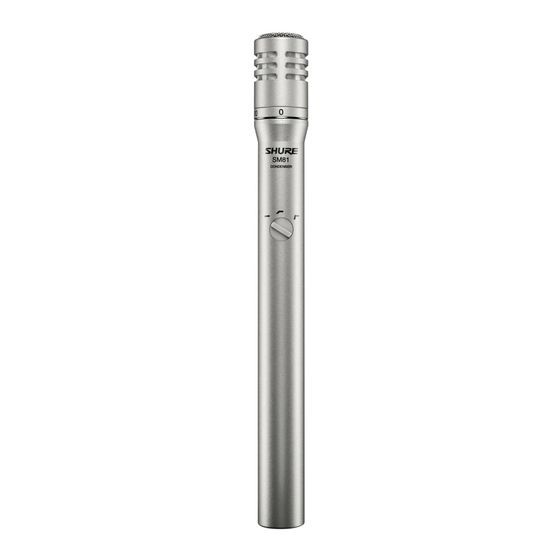Table of Contents
Advertisement
Quick Links
MODEL SM81 UNIDIRECTIONAL
CONDENSER MICROPHONE
The Shure Model SM81 is a high-quality, unidirectional con-
denser microphone designed for studio recording, broadcasting,
and sound reinforcement. Its wide frequency response, low noise
characteristics, and low RF susceptibility have made it a standard
for applications involving acoustic instruments, especially guitar,
piano, and cymbals.
The SM81 is ruggedly constructed. It operates on phantom pow-
er and performs over a wide range of temperatures and humidity
conditions. It is furnished with a swivel adapter, attenuator-switch
lock, foam windscreen, and case for carrying and storage. Other
accessories are available.
Model SM81 Features
•
20 Hz to 20 kHz frequency response
•
Flat response curve for accurate reproduction of sound
sources
•
Low noise and high output clipping level
•
Low distortion over a wide range of load impedances
•
Cardioid polar pattern, uniform with frequency and sym-
metric about axis, providing maximum rejection and min-
imum coloration of off-axis sounds
•
Low RF susceptibility
•
Selectable low-frequency response: flat, 6 or 18 dB/oc-
tave rolloff
•
0 dB/10 dB lockable attenuator switch
•
Phantom powering (DIN 45 596 voltages of 12 to 48 Vdc)
•
Rugged steel construction for durability
•
Field-usable over wide range of temperature and humidi-
ty conditions
2005, Shure Incorporated
©
27C2916 (Rev. 6)
Model SM81 User Guide
SPECIFICATIONS
Type
Condenser (electret bias)
Frequency Response
20 to 20,000 Hz
+20
+10
0
–10
-20
2
20
50 100
TYPICAL FREQUENCY RESPONSE
FIGURE 1
Polar Pattern
Cardioid (unidirectional) response-uniform with frequency, sym-
metrical about axis
180°
150°
150°
120°
120°
90°
–20 dB
–20 dB
–15 dB
–15 dB
60°
–10 dB
–10 dB
–5 dB
–5 dB
30°
30°
0
1000 Hz
500 Hz
100 Hz
TYPICAL POLAR PATTERNS
FIGURE 2
Output Impedance
Rated at 150 Ω (85 Ω actual)
Recommended minimum load impedance: 800 Ω (May be used
with loads as low as 150 Ω with reduced clipping level)
Output Configuration and Connector
Balanced, transformer-coupled output; male XLR connector
Sensitivity (at 1,000 Hz)
Open Circuit Voltage: . . . . . . . . . . . . –45 dBV/Pascal (5.6 mV)
(1 Pascal = 94 dB SPL)
Clipping Level (at 1,000 Hz)
800 Ω Load: . . . . . . . . . . . . . . . . . . . . . . . . . . –4 dBV (0.63 V)
150 Ω Load: . . . . . . . . . . . . . . . . . . . . . . . . . –15 dBV (0.18 V)
Total Harmonic Distortion
Less than 0.5% (131 dB SPL at 250 Hz into 800 Ω load)
1 METER
3
4
5
6
7
9 8
2
3
4
5
6
7
9 8
1000
10000
Hz
180°
150°
120°
90°
90°
–20 dB
–20 dB
–15 dB
–15 dB
60°
60°
–10 dB
–10 dB
–5 dB
–5 dB
30°
0
2000 Hz
5000 Hz
10000 Hz
Printed in U.S.A.
20000
150°
120°
90°
60°
30°
Advertisement
Table of Contents

Summary of Contents for Shure SM81
-
Page 1: Specifications
1000 10000 20000 piano, and cymbals. The SM81 is ruggedly constructed. It operates on phantom pow- TYPICAL FREQUENCY RESPONSE er and performs over a wide range of temperatures and humidity FIGURE 1 conditions. It is furnished with a swivel adapter, attenuator-switch lock, foam windscreen, and case for carrying and storage. - Page 2 *S/N ratio is difference between microphone output at 94 dB SPL and microphone self-noise A-weighted. The SM81 requires phantom power. This may be supplied to the Overvoltage and Reverse Polarity Protection microphone by a mixer, preamplifier or console with built-in phan- Max.
- Page 3 (small clear piece of plastic) in the area behind the actuator ring be- install the A81G, slip it over the SM81 until the inside of the A81G tween the pin and the edge of the slot. This will prevent the ring touches the top of the microphone.
-
Page 4: Furnished Accessories
6 dB and a minimum cancellation at the rear of 15 dB at 1 kHz. The micro- A block diagram of the SM81 is shown in Figure 6. The capacitor phone shall have a rated output impedance of 150 Ω for connec- cartridge is followed by a switch-controlled capacitive attenuator tion to microphone inputs of 150 ohms or higher.












Need help?
Do you have a question about the SM81 and is the answer not in the manual?
Questions and answers